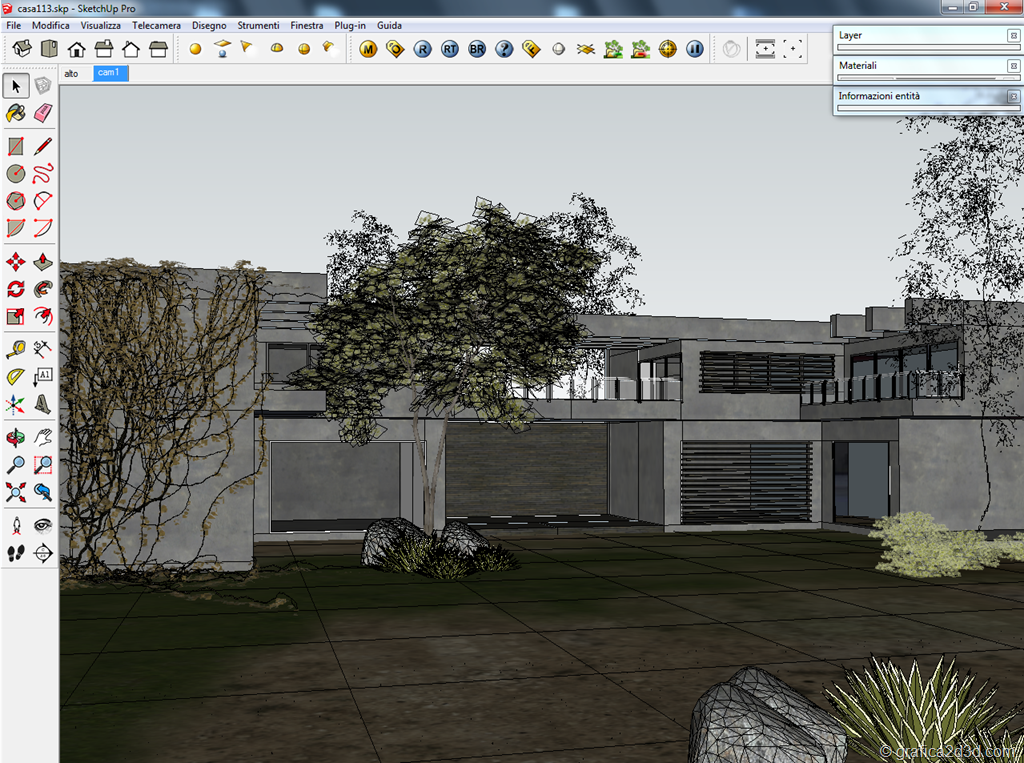

- #VRAY FOR SKETCHUP HDRI HOW TO#
- #VRAY FOR SKETCHUP HDRI 32 BIT#
- #VRAY FOR SKETCHUP HDRI MANUAL#
- #VRAY FOR SKETCHUP HDRI SERIES#
I will not go into information on how to do this, as an alternative I will concentrate on the Television material in this tutorial. Once again this is incredibly effortless to attain in Google SketchUp. This is helpful for Television screens, fire, glowing backgrounds and candle light material.īeneath is a easy scene that I will use to demonstrate how to spot a Television screen map and how to produce fire to proficiently light my fireplace.įor this Television, I have to have to apply the map appropriately to the Television screen. This bitmap will then be applied as self emitting material. After you have developed an Emissive Map Layer, you can truly load a bitmap. This is incredibly effortless to attain in V-Ray for SketchUp. Employing Bitmap as Emissive lightingīitmaps can also be added and produce emissive lighting by applying them. I also added a material to the studio surface.įour. The subsequent render shows a slight reflection therefore producing a considerably far more believable surface.

In the subsequent render I added a Reflection Layer with a Fresnel Map variety. The render under had a incredibly low HDRI’s Bitmap Gamma.Ī single of the most effective attributes of the most recent release of V-Ray for SketchUp is the capability to stack layers.
#VRAY FOR SKETCHUP HDRI SERIES#
In the subsequent image I combined emissive lighting and IBL applying HDRI in the atmosphere (Note: HDRI will be tackled later in the this series of tutorials). Considering the fact that HDRI lighting will be a separate subject in this series, I will not concentrate on this variety of lighting at the moment.
#VRAY FOR SKETCHUP HDRI 32 BIT#
The only distinction is that the image applied as IBL is a 32 bit image, when the colour/image applied to produce a self illuminating surface is eight bit. I think Emissive Lighting and IBL are nearly exact same. Combining with Image Primarily based Lighting (IBL) applying HDRI (Higher Dynamic Variety Pictures) Xem Thêm Fiche métier d’un peintre en bâtiment – Formation et salaire - meilleur formation decorateur interieurĬonclusion: blotchiness can be removed in V-Ray for SketchUp by escalating the HSph Subdivs applying the Irradiance map engine. I essentially raise the HSph Subdivs of my Irradiance map. There is a way on how to get rid of blotchiness. Right here is a fast render with no applying V-Ray for SketchUp default Visopt (Sun, Physical Camera turned off). You can load bitmaps on each Colour and Transparency boxes, by clicking the reduced case “m” on the boxes. Verify Double-Sided, which implies each adverse and good faces will have an Emissive Layer. The parameters of the Emissive Layer are: Colour will be the colour of your Emissive Light/ Transparency, Intensity controls the energy of your Emissive material. Click the Emissive Layer then and spot it on your material stacks. Pick “Create Layer” and then choose “Emissive”. Make material, highlight this material and “right-click” your mouse button. This implies I will be relying completely on Emissive components to light up my scene. Once again, just like my aspect 1 tutorial in this series, the Camera and Physical Sky are turned off. I will be applying this easy scene to show you how to access this material quickly. Emissive material is ordinarily applied as self illuminating material for glow sticks, neon’s, bulbs and LED lights. But just before that, let me reintroduce the standard function of it and how you can access this in V-Ray for SketchUp. In this 2nd Component of my tutorial, I will attempt my most effective to share my understanding and my expertise in applying Emissive material. is this the case even though? Can I possibly generate excellent rendering just by applying Emissive lighting? When I 1st applied V-Ray for SketchUp, I was not encouraged to use pure Emissive Material to light up my model. In other rendering engines, they get in touch with this a “self-illuminating material” or in V-Ray Max it is equivalent to V-Ray Light Material. It also makes it possible for a plane, a face or an object applied with this material to turn into an actual light supply. You will have to have a affordable understanding of SketchUp, rendering and the use of Photoshop for this tutorial.Įmissive Material is truly a specific material layer of V-Ray for SketchUp applied for creating self-illuminated surfaces. In this guide Nomer checks out Emissve components to enable light your SketchUp models.

Nomer continues his wonderful collection of lighting tutorials to enable you get to grips with and simplify this typically complicated approach, with some effortless options to this typically frustrating and confusing aspect to rendering.
#VRAY FOR SKETCHUP HDRI MANUAL#
Also for extra enable V-Ray for SketchUp User Manual Version 1.48. Component 1 in this series can be located right here. This is aspect two of the definitive guide to lighting with V-Ray for SketchUp by Nomer Adona. Lighting with V-Ray for SketchUp – definitive guide aspect two


 0 kommentar(er)
0 kommentar(er)
